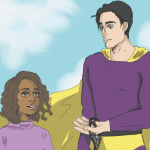How Super-Heroics Can be Used to Fix Society
Upfront, this doesn’t feel like too hard of a pitch. Superheroes are everywhere right now. In film, television, and, uh, comics—dozens of these masked vigilantes force their way into our lives on the daily. The production quality is only getting better as well. The success of TV shows like The Flash, Arrow, Agents of Shield, Daredevil, and Agent Carter would not have been dreamed of ten years ago.
The problem is that even though these characters are so common in our society, we don’t look at them critically enough to realize the true positives and negatives of that presence. We can learn a lot about ourselves by wondering why, now of all times, we have become so obsessed with superheroes.
Yes, marketing, I know, I get it, but let’s try and leave business out for the sake of conversation, capiche?
Firstly, there is an interesting thought idea that comic book characters are based on power fantasies of adolescent young males. So often these characters are transformed from weak, scrawny nerds into large powerful manly-men such as Spiderman, Captain America, Hulk, and Thor (Google “Donald Blake” if you aren’t sure about that last one).
This unfortunately brings the negative qualities of adolescence with it as well. One such quality is an excessively sexual and hateful attitude toward women. Women rarely find a place in superhero universes, and when they do it is essentially as sexual objects.
Like Black Widow being filmed mostly from behind in the Marvel Cinematic universe, or, hey, the fact that in all her time in the modern world Wonder Woman hasn’t converted to pants? And don’t even get me started on racial minorities in general, who either don’t appear or do so as weird old stereotypes (Luke Cage: Huge Afro, Huge Medallion, Black Panther: Literally pretends he is a panther, Blade: just Shaft, but with vampires).
Now, there is some good news. This doesn’t have to be the end all and be all, it turns out. Apparently for the series of DC/Warner Bros. films following Man of Steel producers decided to just go ahead and cast whoever be the coolest in the roles. So we get Jason Momoa of Hawaii playing Aquaman, Ezra Miller who is openly bisexual playing The Flash, and Gal Gadot—an Israel born actress who served in the IDF—playing Wonder Woman.
Marvel is also moving into exploring more of their diverse characters with films based on the Black Panther and Captain Marvel, and their series of Netflix television shows that will see a blind man, a black man, a woman, and hopefully an Asian man *fingers crossed* teaming up to clean up the streets of New York after the Avengers destroyed it.
While it is still possible that these films will be terribly offensive, they do show that executives are beginning to open their minds about having more diverse casts in their movies. It may also allow us to further explore a simple concept with superheroes nobody seems to talk about.
Sure, they are largely based on adolescent fantasies, desperate for power. But there is something incredibly important in the detail that the general understanding of what a superhero should do is to help people. Really think about that for a second. In the power fantasies of adolescent males, the heroes just want to help others.
It isn’t perfect—the world of superheroes is broken down and outdated. But given its current cultural relativity the superhero genre is an obvious candidate to be turned from a hollow sexist and racist fantasy into a device to teach equality, inclusion, and that the best thing a person can do with themselves is be helpful.







